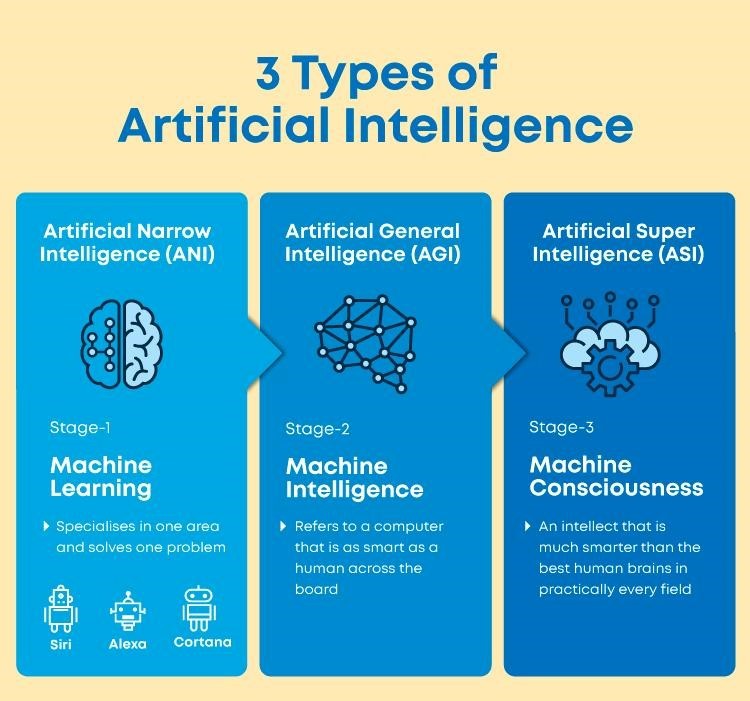What is the Turing Test in Artificial Intelligence?
The basis of the Turing Test is that the Artificial Intelligence entity should be able to hold a conversation with a human agent. The human agent ideally should not be able to conclude that they are talking to Artificial Intelligence. To achieve these ends, the AI needs to possess these qualities:

- Natural Language Processing to communicate successfully.
- Knowledge Representation acts as its memory.
- Automated Reasoning uses the stored information to answer questions and draw new conclusions.
- Machine Learning to detect patterns and adapt to new circumstances.
Cognitive Modelling Approach
As the name suggests, this approach tries to build an Artificial Intelligence model based on Human Cognition. To distil the essence of the human mind, there are 3 approaches:
- Introspection: observing our thoughts, and building a model based on that
- Psychological Experiments: conducting experiments on humans and observing their behaviour
- Brain Imaging: Using MRI to observe how the brain functions in different scenarios and replicating that through code.
The Laws of Thought Approach
The Laws of Thought are a large list of logical statements that govern the operation of our mind. The same laws can be codified and applied to artificial intelligence algorithms. The issue with this approach, is because solving a problem in principle (strictly according to the laws of thought) and solving them in practice can be quite different, requiring contextual nuances to apply. Also, there are some actions that we take without being 100% certain of an outcome that an algorithm might not be able to replicate if there are too many parameters.
The Rational Agent Approach
A rational agent acts to achieve the best possible outcome in its present circumstances. According to the Laws of Thought approach, an entity must behave according to logical statements. But there are some instances, where there is no logical right thing to do, with multiple outcomes involving different outcomes and corresponding compromises. The rational agent approach tries to make the best possible choice in the current circumstances. It means that it’s a much more dynamic and adaptable agent.
Now that we understand how Artificial Intelligence can be designed to act like a human, let’s take a look at how these systems are built.
How does Artificial Intelligence (AI) Work?
Building an AI system is a careful process of reverse-engineering human traits and capabilities in a machine, and using its computational prowess to surpass what we are capable of.
To understand How Artificial Intelligence actually works, one needs to deep dive into the various sub-domains of Artificial Intelligence and understand how those domains could be applied to the various fields of the industry. You can also take up an artificial intelligence course that will help you gain a comprehensive understanding.
- Machine Learning: ML teaches a machine how to make inferences and decisions based on past experience. It identifies patterns and analyses past data to infer the meaning of these data points to reach a possible conclusion without having to involve human experience. This automation to reach conclusions by evaluating data saves human time for businesses and helps them make a better decisions. To learn basic concepts you can enrol on a free machine learning course for beginners.
- Deep Learning: Deep Learning is an ML technique. It teaches a machine to process inputs through layers in order to classify, infer and predict the outcome.
- Neural Networks: Neural Networks work on similar principles to Human Neural cells. They are a series of algorithms that captures the relationship between various underlying variables and processes the data as a human brain does.
- Natural Language Processing: NLP is a science of reading, understanding, and interpreting a language by a machine. Once a machine understands what the user intends to communicate, it responds accordingly.
- Computer Vision: Computer vision algorithms try to understand an image by breaking down an image and studying different parts of the object. This helps the machine classify and learn from a set of images, to make a better output decision based on previous observations.
- Cognitive Computing: Cognitive computing algorithms try to mimic a human brain by analysing text/speech/images/objects in a manner that a human does and tries to give the desired output. Also, take up applications of artificial intelligence courses for free.
What are the Types of Artificial Intelligence?
Not all types of AI all the above fields simultaneously. Different Artificial Intelligence entities are built for different purposes, and that’s how they vary. AI can be classified based on Type 1 and Type 2 (Based on functionalities). Here’s a brief introduction to the first type.
3 Types of Artificial Intelligence
- Artificial Narrow Intelligence (ANI)
- Artificial General Intelligence (AGI)
- Artificial Super Intelligence (ASI)

Let’s take a detailed look.
What is Artificial Narrow Intelligence (ANI)?
This is the most common form of AI that you’d find in the market now. These Artificial Intelligence systems are designed to solve one single problem and would be able to execute a single task really well. By definition, they have narrow capabilities, like recommending a product for an e-commerce user or predicting the weather. This is the only kind of Artificial Intelligence that exists today. They’re able to come close to human functioning in very specific contexts, and even surpass them in many instances, but only excelling in very controlled environments with a limited set of parameters.
To build a strong AI foundation, you can also upskill with the help of the free online course offered by Great Learning Academy on Introduction to Artificial Intelligence. With the help of this course, you can learn all the basic concepts required for you to build a career in AI.
What is Artificial General Intelligence (AGI)?
AGI is still a theoretical concept. It’s defined as AI which has a human-level of cognitive function, across a wide variety of domains such as language processing, image processing, computational functioning and reasoning and so on.
We’re still a long way away from building an AGI system. An AGI system would need to comprise of thousands of Artificial Narrow Intelligence systems working in tandem, communicating with each other to mimic human reasoning. Even with the most advanced computing systems and infrastructures, such as Fujitsu’s K or IBM’s Watson, it has taken them 40 minutes to simulate a single second of neuronal activity. This speaks to both the immense complexity and interconnectedness of the human brain, and to the magnitude of the challenge of building an AGI with our current resources.
What is Artificial Super Intelligence (ASI)?
We’re almost entering into science-fiction territory here, but ASI is seen as the logical progression from AGI. An Artificial Super Intelligence (ASI) system would be able to surpass all human capabilities. This would include decision making, taking rational decisions, and even includes things like making better art and building emotional relationships.
Once we achieve Artificial General Intelligence, AI systems would rapidly be able to improve their capabilities and advance into realms that we might not even have dreamed of. While the gap between AGI and ASI would be relatively narrow (some say as little as a nanosecond, because that’s how fast Artificial Intelligence would learn) the long journey ahead of us towards AGI itself makes this seem like a concept that lies far into the future. Check out this course on how to Build a career in AI.




